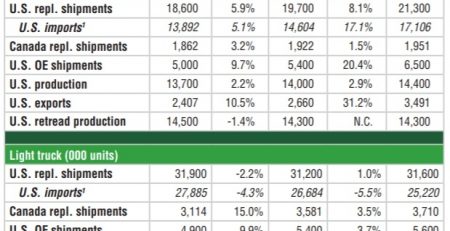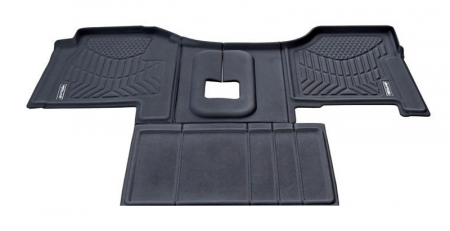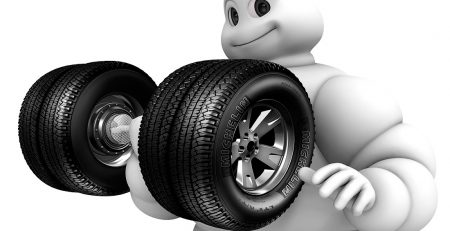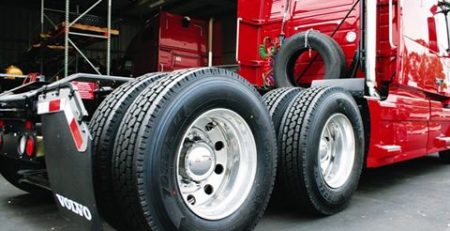Truck Tires Have Developed Into Sophisticated Tools Of Fuel Economy
There are many factors that affect the fuel mileage attained by any given vehicle, including drivers, the shape and condition of the truck, maintenance, routes, climate, load and, of course, tires.
There was a time when drivers preferred “tall rubber,” 11R24.5 tires. The thinking was that the taller the tire, the fewer revolutions per mile and the greater the tire life. But with those tires came more weight and higher taxes. Today, the overwhelming majority of truck tires are low-profile 22.5s, with wide base singles, 445/50R22.5, growing steadily in popularity. A look at the components of modern truck tires and how they function explains why.
Think of them as circular air containers
The main thing to remember always is that the tires do not support the truck. The air inside them does. The primary purpose of the casing of the body of the tire is to contain the air that supports the truck and to manage the relative motions of all of its components. It is a complex, highly engineered structure.
The bead holds the tire on the rim, and around it are cords that run from one side of the wheel to the other, giving the tire its basic cross section, holding in the air and supporting the tread. The radial ply transmits acceleration, braking and steering forces to the tread.
Numerous components manage the forces transitioning between the flexible sidewall’s radial plies and the stiff tread over the steel belts. The belts give the tire its rolling strength and stabilize the tread while protecting the air chamber from punctures.
The tread: lug and rib patterns
The tread is a highly engineered component, composed of a proprietary blend of natural and synthetic rubber, polymer compounds, silica, carbon and other substances known only to the tire manufacturer. The patterns and textures molded into the outer surfaces of the tread provide traction while minimizing wear in the tire’s designed application. Lug patterns are important for off-road driving, where maximum grip is required. Rib patterns, for on-highway use, deliver a smooth ride and fuel economy.
If all roads were always smooth and dry like NASCAR racetracks, we wouldn’t be concerned with tread patterns, but in the real world, we don’t red-flag operations whenever it starts to rain. Grooves are put in treads to channel rainwater and snow. Lugs are designed between grooves of drive tires to provide added traction in dirt, mud and snow. All this is done to maximize the desired attributes of the tire for its selected use, balancing life, traction and fuel economy.
About one-third of fuel consumed by a typical truck goes to overcoming rolling resistance in tires. The tread is responsible for 50 percent to 70 percent of that, according to Peggy Fisher, president of Tire Stamp and past general chairman of the Technology and Maintenance Council.
A switch from lug to rib treads, can result in fuel use savings of 2 to 4 percent. Aerodynamics plays its role in fuel economy once a vehicle exceeds 50 mph. So, when operating below 50, rib treads can have a significant impact — bumping up the savings to 6 percent for trucks traveling in lower speed urban operations.
As long as tires wear evenly, it’s actually beneficial to keep them on the truck as they wear down. The thinner tread flexes less and flexing creates internal friction, which is the main source of rolling resistance. A tire worn to 50 percent of tread depth is 4.5 percent more fuel efficient than a new tire. When nearly worn out but still legal, a drive or trailer tire can get more than 6 percent better fuel economy.
Of course, tire pressure is key
In order to support the weight of cargo and vehicle and to provide traction and maneuvering forces, tires compress to form a contact patch with the ground. As the vehicle rolls, part of the tire is stationary on the road. It forms the contact patch. When the tread, which has flattened, is no longer in contact with the road, it springs back to its original round shape, expanding out a bit before settling back to its constant radius. This flexing causes friction inside the tire. That causes heat. Too much can destroy tires. At the least it contributes to poor fuel mileage and shorter tire life. Air pressure resists and limits this flexing.
Underinflated tires can reduce fuel economy. In a study done by TMC and FMCSA in 2002, only 44 percent of about 90,000 tires actually gauged were found to be within 5 psi of their target pressure, and manual tire monitoring practices have not changed much since then. What has improved is the increased use of tire pressure maintenance systems, specifically the TPMS made by Pressure Systems International and sold by Meritor. Since its introduction, others have entered the market for trailers only. The systems draw air from the compressor through the hollow tube trailer axle, through a rotary union to the tire needing air. Other systems use tubing or hoses to move air through the axle, but this is impractical for a live (with a driveshaft) axle.
In 2014, Aperia introduced the Halo tire inflation device. The Truck Writers of North America felt inflation was so important, they gave it their Technical Achievement of the Year Award. The Halo uses a hub-mounted pump to maintain air pressure even with a sizable air leak, although it cannot inflate an already flat tire.
Tires are systems designed to do specific jobs. All require sufficient inflation pressure to perform well, just as all require highly engineered components — tread designs, rubber compounds, structures and configurations designed to work together to achieve their goal.
Source: http://roadking.com/trucks/
Visit us:
301 W Gerri LnAddison, IL 60101
Contact us:
Phone: +1 224 422 2829
Mail: info@tire-max.com











